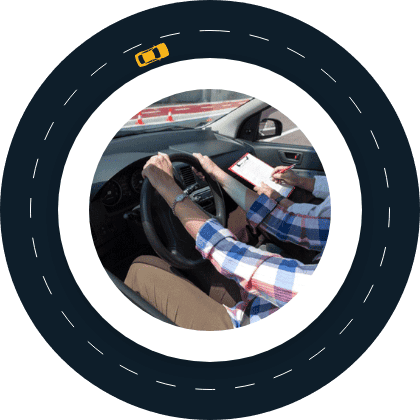- Need Any Help: +1 647-760-5505 or
- info@trubicars.ca
The Trubicars driver instruction course gives participants the opportunity to interact on multiple levels. Practice activities that have been integrated into the course include many scenario-based questions and activities that help to reinforce the material while improving retention of the information.



To get an Ontario driver’s license, you must first visit a DriveTest Centre and demonstrate your ability to drive smoothly, safely, and legally. Once you have passed the written test, you will have a G1 license. Once ready, you can attempt the first of two Road Tests for Cars, Small Trucks, and Vans. Let’s break that down for you.
The G2 class road test and the G class road test: Both tests enable professional driver examiners to evaluate your ability to apply the rules of the road, handle your vehicle, and demonstrate your ability to drive safely. Road tests for both G2 and G classes are available all year.

Let’s begin with the G2 class road test. This test will assess your basic driving skills. This type of test is commonly referred to as a “city test,” and will typically take roughly 20 minutes, depending on the amount of traffic. If you are successful after completing this test, you will have a Class G2 license.
As a new driver with a G1 class license, you will need to gain a minimum of one year of driving experience before you qualify to attempt this test. Taking an approved BDE course at an MTO-recognized driving school, the wait time for the road test is reduced by four months. You would be able to do the road test after eight months instead of twelve.
Attempting the G Class Road test will assess more advanced driving skills, including a highway/freeway component. This G-Class road test will typically take roughly 30 minutes to complete. If you are successful after this test, you will be issued a G Class license.
To be able to attempt the G Class road test, you will be required to practice driving for at least one year after you have received your G2 Class license. There is no way to reduce the wait time to attempt this road test.
Once you have reached the mandatory wait times and have enough experience to drive on your own, you can book your road test. To book the test, you will need your driver’s license number and the ability to pay any fees Novice drivers in the graduated licensing program may not schedule a road test once their driver’s license has expired. Keep an eye on the expiration date of your license.
Note: DriveTest is helping to clear the backlog of in-vehicle road tests resulting from COVID-19 restrictions and closures. The G Class road test has been temporarily adjusted at all permanent and temporary DriveTest Centre locations. Any part-time Travel Point DriveTest locations will continue to offer the full standard G Class road test.
What this means is, until further notice, the G Class road test will not include the following elements that are
already covered in the G2 Class road test:
The Beginner Driver Education (BDE) courses are optional for any new driver but recommended by the Ministry of Transportation (MTO). Use Trubicars to book the best driving school near you. Before taking any road test, study the Official MTO Driver’s Handbook and take the Trubicars road test course to ensure the meaning of signs and the rules of the road are fresh in your mind.

If you are taking a G Class road test (the highway test), before the test, you must declare your driving experience to ensure you have spent sufficient time on highways. You must declare how many times in the last 3 months you have driven on a highway with a speed limit of at least 80 km/hr or a 400-series highway. The 400-series highways would include the following:
To qualify for the G Class road test, you must have driven at least five times on at least one of these roadways in the last three months. You must indicate the average length of these trips, such as under 5 km, between 5 and 15 km, or over 15 km. Please ensure you have the minimum required highway driving experience before your road test date, or your road test will be canceled. You will lose 50% of your road test fee.
Bring a G Class vehicle with you on the day of the road test. To ensure you can go for your road test, ensure you make any required repairs to ensure the vehicle will meet the minimum requirements and is in good working order. If the vehicle does not meet the minimum standards, your road test could be declared “out-of-order”. The vehicle you bring to your road test can be owned, borrowed, or rented. It does not need to be a vehicle from a driving school.

Please arrive a minimum of 30 minutes before the time of your road test. Road tests will continue in any weather situation unless otherwise notified. In the case of extreme weather, your road test may be rescheduled or postponed for safety reasons. If the weather is severe or has the possibility of changing from good to bad, you can check the DriveTest webpage to see if your road test will continue.
When you arrive for your test, please park your vehicle in the designated area for road tests and go inside the DriveTest Centre. Most of the DriveTest Centres have a self-serve kiosk for check-in. If the DriveTest Centre does not have one or it is not working, see a customer service agent. After you check in, return to your vehicle, put on your seatbelt, and wait for the Driver Examiner. If the Driver Examiner does not arrive at your vehicle within 30 minutes of your road test time, return to the building and proceed to Counter A.
Have you traveled in the past 30 days?
Are you experiencing any signs or symptoms of illness, such as cough, sneezing, fever, increased difficulty breathing, or flu-like symptoms?
If you answered “yes” to these questions or displayed visible flu-like symptoms, your road test will not continue, but it will be rescheduled without penalty.
Any in-vehicle recording devices in your vehicle, such as a dashboard camera, must not be facing the passenger area. Refusing to follow this requirement will result in your road test appointment being canceled, and you will lose 50% of your road test fee. You will then have to pay the outstanding 50% to schedule another road test appointment.
During the road test, no pets are allowed in the vehicle. Passengers other than the driver examiner cannot be in the vehicle. Any passengers can wait in the designated safe areas. Driver examiners train to accommodate all customers, including people with disabilities. Road test participants can use a translator or driving instructor during the check-in and after the road test for debriefing with the driver examiner.




A vehicle in good working order.
Glasses or contact lenses if you are required to wear them while driving.
Enough fuel in the vehicle to take the test.
Your current driver’s license.
A printout of your road test confirmation email.
Any money required for test fees (if you are hoping for a standby road test appointment).
Before you begin the road test, the driver examiner will explain the test to you. The driver examiner is not allowed to coach you, so if you have any questions, ask them before you begin the road test after their initial explanations. Before getting in the vehicle, the driver examiner will walk around it to look for damage, safety hazards, and any obstacles. The driver examiner may stop or refuse to start the road test for the following reasons:

Your vehicle is not in good working order.

You show possible signs of impairment from either alcohol or drugs.

Your driving skills are not good enough to complete the road test safely.
While taking the road test, the examiner will evaluate your skills according to a set of criteria and will complete a form or scoresheet. Check the Trubicars driving test course page to learn more about the driving tests.
Once completed, the driver examiner will provide a brief, verbal conclusion of your driving skills. If you require a paper copy of the scoresheet, they are available upon request within 13 months of the test date. You will need to go inside the center to retrieve it.
After passing the road test, you will receive a temporary driver’s license, valid for 90 days or until you receive your permanent driver’s license photo card in the mail.
If you are unsuccessful on the road test, the scoresheet will show you where you need to improve. When you have had more practice, especially in the areas of concern, you can make an appointment to do the road test again. You may take as many road tests as you need to pass, provided your current driver’s license is still valid. However, you must wait for a minimum of 10 days between road tests. You will pay applicable road test fees once you book the new test.

At Trubicars, our driving instructors are there to help you with the road test process and to help you with the little things to make the experience a good one. For more information, check out the Trubicars website!
